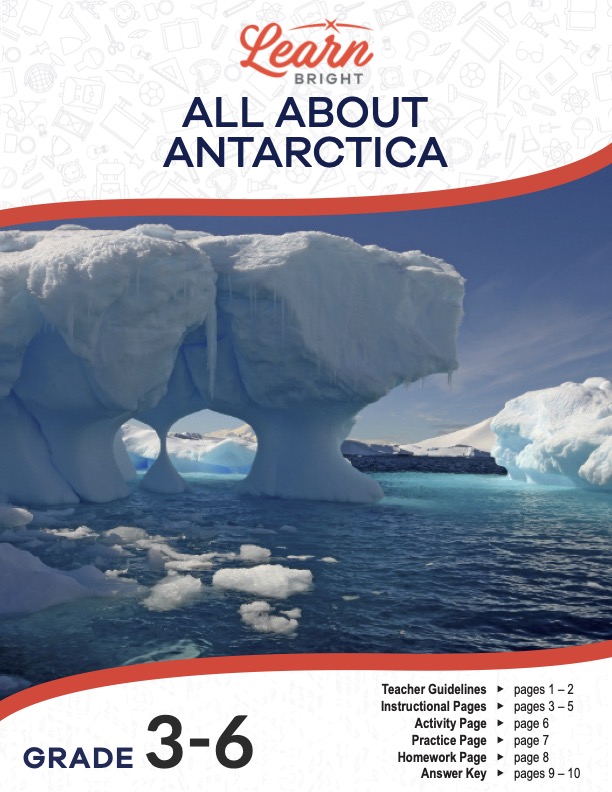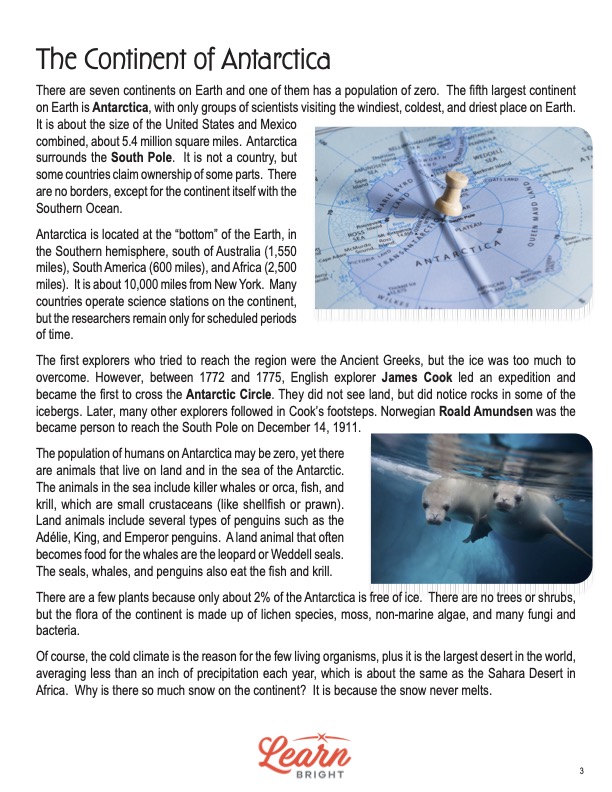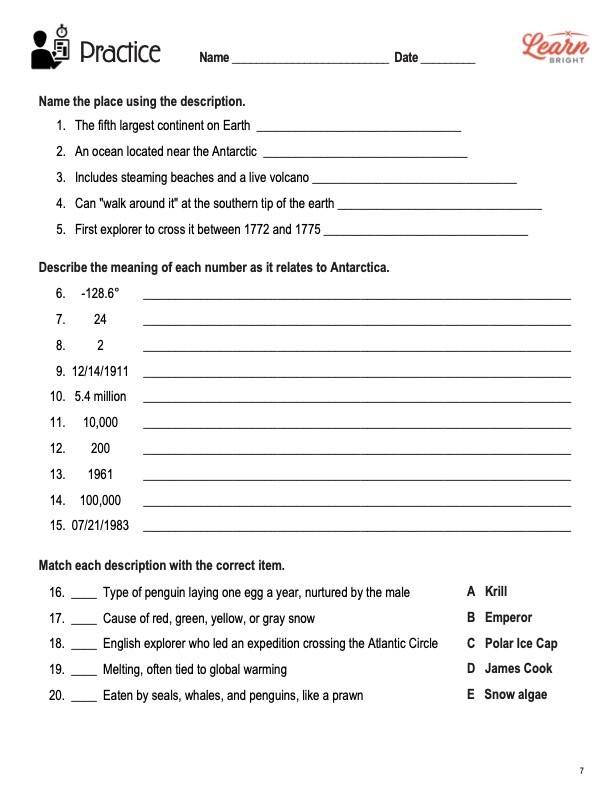Description
What our All About Antarctica lesson plan includes
Lesson Objectives and Overview: All About Antarctica lesson plan introduces students to the continent of Antarctica. The lesson discusses the location of Antarctica and the first explorers to visit the continent. The lesson briefly mentions the animals that live in Antarctica such as seals and penguins, and also touches on the Southern Ocean and polar ice caps. At the end of the lesson, students will be able to locate the continent of Antarctica on a map, list some of the characteristics of Antarctica, and explain some of its history. This lesson is for students in 3rd grade, 4th grade, 5th grade, and 6th grade.
Classroom Procedure
Every lesson plan provides you with a classroom procedure page that outlines a step-by-step guide to follow. You do not have to follow the guide exactly. The guide helps you organize the lesson and details when to hand out worksheets. It also lists information in the orange box that you might find useful. You will find the lesson objectives, state standards, and number of class sessions the lesson should take to complete in this area. In addition, it describes the supplies you will need as well as what and how you need to prepare beforehand. To prepare for this lesson ahead of time, you can pair students for the activity and copy the handouts.
Options for Lesson
Included with this lesson is an “Options for Lesson” section that lists a number of suggestions for activities to add to the lesson or substitutions for the ones already in the lesson. One optional addition to this lesson is to invite someone who has been to Antarctica to speak to your class about what it was like. You can have your students create 3D models of Antarctica, including animals. Another option is to hold a class discussion on global warming and the melting ice caps. You can also have students watch a video (found in the lesson resources) and identify one or more of the tourist attractions. Finally, you can assign students an animal to research and present to the class.
Teacher Notes
The teacher notes page includes a paragraph with additional guidelines and things to think about as you begin to plan your lesson. This page also includes lines that you can use to add your own notes as you’re preparing for this lesson.
ALL ABOUT ANTARCTICA LESSON PLAN CONTENT PAGES
The Continent of Antarctica
The All About Antarctica lesson plan includes three pages of content. The lesson begins by explaining that the Earth has seven continents, but only one of them has a population of zero! Antarctica is the fifth largest continent, and is the windiest, coldest, and driest place on Earth. The only people who visit there are groups of scientists. It is approximately 5.4 million square miles, or the size of the United States and Mexico combined, and surrounds the South Pole. Antarctica is not a country, and there are no internal borders, though some countries claim to have ownership of some parts of it.
The continent is at the bottom of the Earth. It’s in the Southern hemisphere and is about 1,550 miles south of Australia, 600 miles south of South America, and 2,5000 miles south of Africa. Different countries have science stations there, but the researchers don’t live there full-time.
The Ancient Greeks tried to reach Antarctica, but they couldn’t overcome the ice. Explorer James Cook led the first people across the Antarctic Circle between 1772 and 1775. Though this expedition did not encounter land, they did see rocks in some icebergs. Other explorers then started traveling to the region. On December 14, 1911, Norwegian explorer Roald Amundsen became the first person to get to the South Pole.
While no humans live on the continent, many animals live on the land and in the sea. Some sea animals include killer whales, orcas, fish, and krill. Some of the land animals include different types of penguins (Adélie, King, and Emperor) and leopard and Weddell seals. Whales often eat the seals, while seals, whales, and penguins eat the fish and krill.
Antarctica doesn’t have many plants, because only 2% of the continent doesn’t have ice. The continent doesn’t have any trees or shrubs, but there are lichen species, moss, non-marine algae, fungi, and bacteria. There are so few living organisms because the climate is so cold. Antarctica is the largest desert in the world and averages less than an inch of precipitation a year—about the same as the Sahara Desert. There’s so much snow on the continent because it never melts.
The ice on Antarctica covers almost the whole continent and is, on average, more than a mile thick. In some places, it’s three miles thick. This ice and snow has accumulated over millions of years. We can find about 90% of the ice on the entire Earth on this continent. If it melted, the sea levels around the world would rise over 200 feet.
Antarctica still has seasons, even through it’s so cold. They have winter from March to September and summer from October to February. Once the sun sets in March, it doesn’t rise again until October. Antarctica has constant sun for six months, and then constant dark for six months. The snow algae can change the color of the snow in some parts of the continent during the summer, making it look red, green, gray, or yellow.
The size of the continent almost doubles during the winter because so much of the water around it freezes. This water is the Southern Ocean, where temperatures range from -49°F to -56°F. The coldest temperature ever recorded was -128.6°F, on July 21, 1983. Ground temperatures can reach less than 135 degrees below zero, and winds can reach up to 200 miles an hour, lowering the temperatures even more.
The Attractions of Antarctica
Even though the majority of the people who visit Antarctica are scientists, almost 100,000 tourists visit the continent every year to see its landscape and wildlife. Deception Island is close to an active volcano and has steaming beaches and scalding water. You can find whales nearby. Emperor Penguins roam the continent, with the females laying one egg per year. The Polar Ice Cap is thick and has layers of snow and animals roaming its surface. We often connect the melting of the Ice Cap with global warming. The South Pole, home of Santa, can reach temperatures of -120°F.
No country or person owns Antarctica, and people signed the Antarctic Treaty in 1961. This treaty aims to control human activity on the continent and resolves any disagreements about territory. Any scientists who conduct experiments there must share their results with the people who signed the treaty, they must care for the environment there, and they can only use the land for peaceful purposes.
Key Terms
Here is a list of the vocabulary words students will learn in this lesson plan:
- James Cook: English explorer who led an expedition crossing the Atlantic Circle
- Antarctic Circle: The first explorer crossed it between 1772 and 1775
- Roald Amundsen: The first person to reach the South Pole in 1911
- Snow algae: Cause of red, green, yellow, or gray snow
- Southern Ocean: An ocean located near Antarctica
- Deception Island: Includes steaming beaches and a live volcano
- Emperor Penguins: Type of penguin laying one egg a year, nurtured by the male
- Polar Ice Cap: Melting, often tied to global warming
- South Pole: Can “walk around it” at the southern tip of the Earth
- Antarctic Treaty: Outlines strategies to help control human activity and resolve disagreements over territory
ALL ABOUT ANTARCTICA LESSON PLAN WORKSHEETS
The All About Antarctica lesson plan includes three worksheets: an activity worksheet, a practice worksheet, and a homework assignment. You can refer to the guide on the classroom procedure page to determine when to hand out each worksheet.
ANTARCTICA TREATY ACTIVITY WORKSHEET
Students will work with a partner to complete the activity worksheet. Each pair will review the various parts of the Antarctica Treaty and then answer a few questions. These questions ask them what other rules they would add to the Treaty, if they think all continents should have rules like these, and what ten rules they believe all continents of the world should follow.
Students may work either alone or in groups for this activity if you’d prefer.
ALL ABOUT ANTARCTICA PRACTICE WORKSHEET
For the practice worksheet, students will complete three short exercises. For the first, they will name the place using the provided description. Then, for the second, they will describe the meaning of each number as it relates to Antarctica. Finally, for the third, they will match each description with the correct term.
ACROSTIC POEM HOMEWORK ASSIGNMENT
The homework assignment asks students to create an acrostic poem using the letters ANTARCTICA. Their poem can be about the continent or other facts related to the continent. They will also guess whether ten facts are about penguins, whales, or seals.
Worksheet Answer Keys
This lesson plan includes answer keys for the practice worksheet and the homework assignment. If you choose to administer the lesson pages to your students via PDF, you will need to save a new file that omits these pages. Otherwise, you can simply print out the applicable pages and keep these as reference for yourself when grading assignments.










